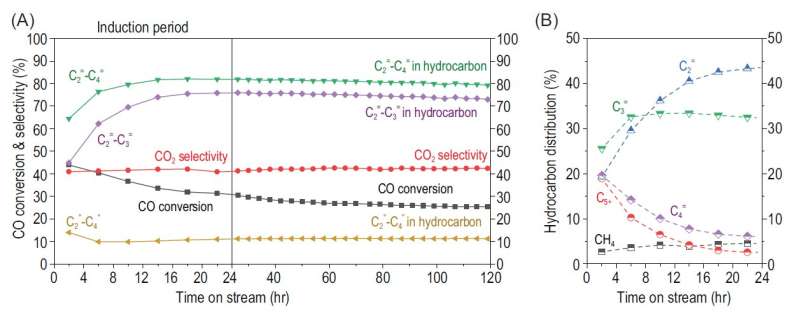(A) Dynamic evolution of performance with time on stream. (B) Hydrocarbon distribution during the induction period. Credit: Science China Press
Syngas conversion, as the core technology for efficient and clean utilization of carbon resources such as coal, natural gas, CO2 and biomass, has received extensive attention from both academia and industry. An increasing number of studies demonstrate that OXZEO (oxide-zeolite) bifunctional catalyst concept provides an effective technology to tackle the selectivity challenge encountered in the conventional syngas conversion processes.
Within the framework of OXZEO concept, the product selectivity can be modulated by the confined zeolitic pores with different acidities and topologies. Previous studies have shown the confinement and shape-selectivity of zeolites during steady-state reactions.
In this study, the team reports a dynamic confinement effect of zeotype cages, which controls the product selectivity during the induction period of syngas conversion. For instance, the ethylene selectivity rises from 19% gradually to 44% whereas C4+ hydrocarbon selectivity declines from 39% to 9% within the first 22 hrs on stream. After the induction period, the catalytic performance levels off.
Characterization with structured illumination microscopy, intelligent gravimetric analysis, UV-Raman, X-ray diffraction, thermogravimetry and gas chromatography-mass spectrometer analysis indicates that this is induced by the gradual accumulation of carbonaceous species inside the SAPO-17 cages as the reaction proceeds. It leads to a gradually decreased free space inside the cage.
The diffusion coefficient ratio of C2 to C4 (denoted as DC2/DC4) is correlated negatively with an Effective Space Coefficient, (ESC), a descriptor that is defined to describe the effective space inside the SAPO-17 cage. It indicates more hindered diffusion for C4 than for C2 with the reduced free space of the cage.
Furthermore, a restricted free space would also hinder the secondary reaction of ethylene and therefore benefits C2 selectivity. This reveals a significant effect of the dynamic confinement of SAPO-17 cage on the product selectivity. Although the most of micropores are occupied (93%) when the induction period is completed, the catalyst is not deactivated and it is running rather stably in syngas conversion.
This dynamic confinement is expected to be general for a number of reactions involving hydrocarbons over zeolites. The understanding is essential for further design of high-performance zeolites-based catalysts for C1 chemistry as well as other reactions involving hydrocarbons.
This study was published in National Science Review.
More information: Haodi Wang et al, Dynamic confinement of SAPO-17 cages on the selectivity control of syngas conversion, National Science Review (2022). DOI: 10.1093/nsr/nwac146
Provided by Science China Press
























